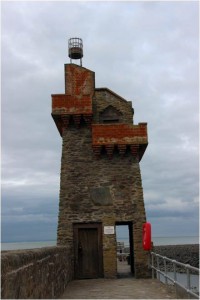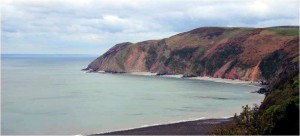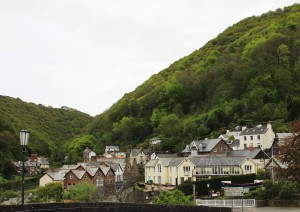In this post:
- From bleak prospects to new chances
- Exclusive to the bold and daring?
- Poets and painters lead the way
- Alarm! A radical at Lynmouth
- Lynton and Lynmouth as settings of a novel – plot bunnies included
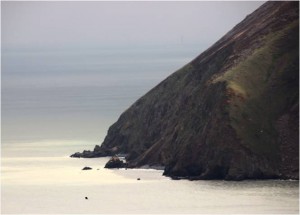 Reverend John Skinner shuddered as he looked at the narrow path ahead. The passage, just four feet or a meagre 1.2 m wide, was cut on the side of a cliff that descended steeply towards the sea. He dismounted his horse and continued his dangerous journey on foot, leading the animal behind him.
Reverend John Skinner shuddered as he looked at the narrow path ahead. The passage, just four feet or a meagre 1.2 m wide, was cut on the side of a cliff that descended steeply towards the sea. He dismounted his horse and continued his dangerous journey on foot, leading the animal behind him.
The Reverend enjoyed discovering the wilderness of Exmoor. In 1801 he reached Lynton and Lynmouth, two tiny villages on the North Devon coast. ‘To travelers not accustomed to a mountainous country, the approach to this place would have deemed impassable’, he noted in his journal. John Skinner was among the first who made their way to Lynton and Lynmouth to admire the view and dramatic scenery. More were to follow. And this was all because of the French.
From bleak prospects to new chances
If the French hadn’t declared war on Britain in 1793, neither of the following might have happened:
- the English began to discover the remote areas of their island, as they were cut off travelling to the popular destinations at the Continent,
- The inhabitants of the tiny villages of Lynton and Lynmouth had to abandon their quiet live of spinning wool, selling bark and smuggling. The war made it impossible to export wool and other products. Hard times were ahead.
Aware of the bleak prospects but also of England’s new interest in Devon, Mr Litson, a wool spinner from Lynton, had an idea to make money: opening a hotel for travellers. He was probably encouraged by the success of the resort villages of the South Devon coast. They had set an example to aspiring hotel managers by even catering for royal visitors. Why shouldn’t Lynton become a sought-after resort as well?
Exclusive to the bold and daring?
The only way to reach Lynton, nestled in the steep hills of the North Devon coast, by land was via a track that resembled the bed of a torrent. It took ages to get there from London: a carriage drive from London to Barnstaple took 59 hours – and then the long, hard 20-miles-journey to Lynton and Lynmouth lay still ahead. Carriages couldn’t reach the village, and even if one went by horse, it was advisable to be as cautious as Mr. Skinner and dismount. Going by boat to Lynmouth, located directly by the sea, wasn’t a save option either: You could go by packet boat, which left from Bristol twice a week, but bad weather might prevent it from entering the harbour, so it had to pass by.
It would take true explorers or incorrigible romantics to make their way to Lynton and Lynmouth.
Poets and painters lead the way
Among the first visitors to Lynton and Lynmouth were artists and writers. Samuel Taylor Coleridge and William Wordsworth visited in 1797, and Robert Southey followed their example in 1799. They were enchanted by the Valley of Rocks near Lynton. The vale was surrounded by huge stones, and fern grew wildly. It must have been an inspiring place. Coleridge is said to have planned his famous Ballad of the Ancient Mariner while walking to the Valley of Rocks.
Watercolourist and landscape painters such as Joseph Farington (you can look at a print of his painting here) and William Daniell (click here to look at his painting) were attracted by the fine views.
Travellers considering themselves to be explorers – such as Reverend Skinner in 1801 – also came to the North Devon coast. They were especially interested in the Valley of Rocks and went there to look for stone circles, altars and druids cults.
Besides its landscape, Lynton had another asset: herds of wild deer roamed freely in the area. They turned out to be an attraction for the gentry. Free roaming wild deer had become rare in England; the existence of these herds made Lynton an ideal location for stag hunting. Former wool spinner Litson enlarged his hotel and catered for the gentry from 1807.
Despite the spectacular beauty of the landscape, Lynton and Lynmouth didn’t “take” as resorts during the Regency period as their counterparts on the South Devon coast did. No member of the Royal Family showed up. But the two villages became popular by persons seeking unspoiled scenery, adventure, inspiration and tranquillity.
Alarm! A radical at Lynmouth
Tranquillity, however, was about to be shaken. The 19-year-old poet Percy Bysshe Shelley arrived in Lynmouth in 1812 for a honeymoon with his 16-year-old bride Harriet Westbook. He stayed at a pretty little cottage called Mrs Hooper’s Lodgings.
At that time, Shelley was strongly attracted to both “radical” ideas and science. Besides composing his first large poetic work “Queen Mab; A Philosophical Poem” in Lynmouth, he wrote several tracts, among them “A Declaration of Rights”. It consisted of 31 theses which were considered radical and dangerous. Here is an excerpt:
“A Christian, a Deist, a Turk, and a Jew, have equal rights: they are men and brethren.”
“Man, whatever be his country, has the same rights in one place as another, the rights of universal citizenship.”
“A man has not only a right to express his thoughts, but it is his duty to do so.”
With “A Declaration of Rights”, Shelly created a kind of artistic-political “happening” at the beach of Lynmouth. He placed numerous copies of the tract in hand-made, water-proof toy boats and launched them into the Bristol Channel. Other copies were fixed to a series of miniature silk-covered fire balloons sewn by Harriet. They floated toward Wales and Ireland.
True to form, Shelley also wrote a poem about the event. You can read it here.
The happening didn’t go unnoticed by the local authorities. Two bottles containing the “dangerous” pamphlets could be secured, and the town clerk of Barnstaple even reported the incident to Lord Sidmouth, the Home Secretary. But local authority didn’t strike yet.
However, when Shelley sent his manservant Daniel Healy to the surrounding villages to distribute his radical tracts, he had gone too far. Mr Healy was arrested and convicted to 6 month in prison. Shelley tried to release his manservant but failed. All he could do was to pay 15 shillings a week to make Healy’s stay in prison more comfortable – money he could ill afford.
Shelley and Harriet were now under observation by the local authorities. Not at all happy with the situation, they borrowed money from their landlady and bribed a boatman to take them to Wales.
Today, there is a hotel at the spot of Mrs Hooper’s Lodgings where Shelley had stayed. It is named after him.
Make Lynton and Lynmouth settings of your Regency Novel
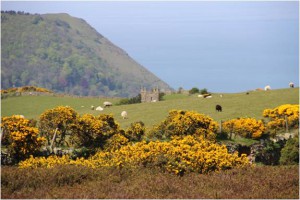 Lynton and Lynmouth are great to use as locations in your Regency novel, if you like to extend your story beyond the gossip and balls of London and other typical watering holes. To include aspects of discovery and romanticism in the Regency period, Lynton and Lynmouth make a great setting. Here are some more facts for you to use:
Lynton and Lynmouth are great to use as locations in your Regency novel, if you like to extend your story beyond the gossip and balls of London and other typical watering holes. To include aspects of discovery and romanticism in the Regency period, Lynton and Lynmouth make a great setting. Here are some more facts for you to use:
- In 1801, 471 people lived in Lynton and Lynmouth. They made their living mainly by farming, fishing, and selling oak bark for tanners, but also by smuggling. The harbour at Lynmouth offered one of the few proper landing places for free traders at the North Devon coast. The inn “The Rising Sun” was reputedly a smuggler’s pub.
- Lynmouth consisted mainly of a harbour, sheds and pits where herrings where cured. Lynton featured a coaching house, “The Crown”, offering basic accommodation for travellers from 1760. Mr Litson opened his hotel in 1800. Several other people from Lynton soon followed his example.
- Neither Lynton nor Lynmouth featured fashionable entertainments such as assembly rooms, circulation libraries, theatres or a promenade. The villages relied on the scenery to attract visitors. A traveller remarked: “With such a scene before me how poor in comparison seemed the gaieties of the town.”
- Besides the deer, other free roaming herds were those of feral goats in the area of the Valley of Rocks. The feral goats had the habit of killing sheep by butting them off the cliffs, much to the dismay of local farmers.
- If you went to Lynton and Lynmouth from London by carriage, an overnight stop in Taunton was obligatory. From Taunton you could continue to Barnstaple by coach service, running 2-3 times a week. The coach could only make 2 miles per hour, due to the bad road.
So how about plot bunnies involving Lynton & Lynmouth?
- Imaging Mr B., the handsome eldest son of a gentleman from Bristol. He had met and fallen in love with Miss C, the daughter of the Lynton Riding Officer. He knows that Miss C.’s father is not happy with the match, fearing that marrying above her rank would make his daughter unhappy. Nevertheless, Mr. B wants to see Mr C. and asks for his daughter’s hand in marriage. He thus sails by packet boat from Bristol to Lynmouth. The weather turns rough due to a sudden thunder storm. The packet boat is badly shaken and nearly capsizes. The unfortunate Mr B. is plunged into the sea. Luckily another boat passes by and picks him up. Safely on board of the new ship, Mr B. soon realises that his rescuers are free traders. They bring him safely to the shore. Mr B. is in a moral conflict: Telling his prospective father-in-law would further his changes with Miss C. But can he really betray the persons who have saved his life?
- Or are your heroine and her brother, Mr and Miss N., interested in the ancient cults of druids? They have come to Lynton to make sketches of the Valley of Rocks. Unfortunately Mr N. catches a cold soon after their arrival. Miss N. thus ventures out into the Valley of Rocks on her own. There she meets another traveller, a young man, Mr. R. He seems to be a poet strolling along the coast for inspiration. They get along very well. Mr. N. also approves the new acquaintance. But then rumours start: Mr R is a radical. He writes seditious poems. He might be a French spy and even plot a revolution. The local authorities search Mr R.’s rooms in the hotel. They find some radical texts ready for distribution in the area and arrest him. Mr and Miss N. are shocked. Can they free him from prison – or is there more truth in the rumours than they know?
- Maybe your heroine, Miss A., and her maid take a walk to Countisbury Hill near Lynmouth. A herd of feral goats roams the area. Miss A. and the maid witness how a goat butts a lamb over the cliff. Miss A., who is very fond of animals, hurries to the spot of the incident. The lamb has fallen on a ledge. It is hurt but not dead. Miss A. tries to rescue it and climbs down to the ledge. She slips and sprains her ankle. She can’t stand up. Her maid rushes back to Lynmouth for help. But before she returns, a dark, tall and handsome stranger comes along. He hears Miss A. call out for help. Can he rescue her? And what will arise from the encounter?
Sources
Travis, John F.: The rise of the Devon seaside resorts 1750-1900, University of Exeter press, 1993.
Kirsch, Adam: Avenging Angel; Inside Shelley’s Manichaean mind, in: The New Yorker, August 27, 2007 http://www.newyorker.com/magazine/2007/08/27/avenging-angel
Buxton Forman, H. (editor): The Works of Percy Bysshe Shelley in Verse and Prose, 1880.
http://www.shelleyslynmouthexmoor.co.uk/shelleyshistory.html
http://www.visitlyntonandlynmouth.com/
http://www.southwestcoastpath.com/walksdb/247/

